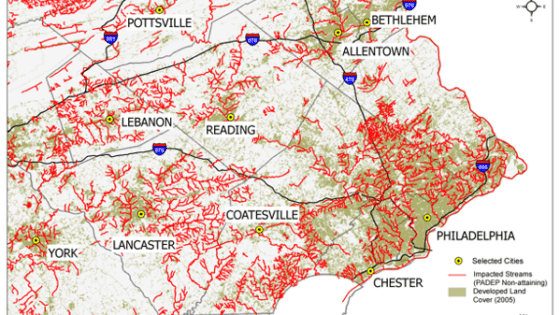By Bernard W. Sweeney, Ph.D., Director, Stroud Water Research Center
Fresh water is our most precious natural resource, as essential to life as the air we breathe. Fortunately, most of us in the United States don’t have to give it much thought, thanks, in large part, to the federal Clean Water Act, passed in 1972.
But ongoing confusion over what “Waters of the United States” fall under the law’s jurisdiction spurred the U.S. Environmental Protection Agency to propose a clarification. This would enable the agency to better protect our wetlands, small streams and other important watershed features without being dragged into court every time someone wanted to avoid compliance by exploiting an ambiguity. The public comment period for this rulemaking closes at midnight tonight (November 14).
I can only hope that the EPA has been inundated with comments supporting the clarification so that our fresh water resources will be neither subject to the vagaries of state and local authorities, nor to the whims of private landowners.
However, I’m worried because the EPA has been barraged by an army of opponents. Developers, property rights groups, the American Farm Bureau, the fertilizer industry and a number of politicians have been attacking the proposed clarification, using inflammatory language like “overreach,” and “land grab.” Some are even telling farmers that the EPA would be regulating puddles, farm ponds and upland ditches that don’t flow into a stream — none of which is true.
Their arguments seem to ignore that the EPA’s proposed clarification is informed by decades of scientific research about freshwater ecosystems, such as the work our scientists have been doing since 1967. The River Continuum Concept, published in 1980 by a team of scientists led by Stroud Water Research Center, is a foundational concept in freshwater ecology. It states that a river system represents a physical, chemical, and biological continuum from the smallest headwater streams to the main stem river at its confluence with the estuary. Subsequent research around the world has not only supported this concept but demonstrated that, in fact, small headwater streams are the most critical and most vulnerable parts of a river.
Our scientists were part of the scientific advisory panel that helped the EPA’s Office of Research and Development conduct a comprehensive review of more than 1,000 peer-reviewed publications in the scientific literature. This report (U.S. Environmental Protection Agency, Connectivity of Streams and Wetlands to Downstream Waters: A Review and Synthesis of the Scientific Evidence, Washington, DC: U.S. Environmental Protection Agency, 2013) concludes:
“The scientific literature clearly demonstrates that streams, regardless of their size or how frequently they flow, strongly influence how downstream waters function. Streams supply most of the water in rivers, transport sediment and organic matter, provide habitat for many species, and take up or change nutrients that could otherwise impair downstream waters.”
Moreover, more than 85 percent of the nation’s stream miles are small enough to jump across and many — if not most — of these flow through private property. So, while opponents may object to the EPA having jurisdiction over streams on private land, landowners should not have the right to pollute streams running through their property as they please.
The science tells us that watersheds with protected wetlands, streamside forest buffers and other best management practices can support both humans and wildlife in a sustainable way. They trap and store sediments; filter out contaminants; reduce the frequency and severity of flooding by slowing the release of storm water; mitigate thermal pollution caused by deforestation, industrial inputs and water diversions; and replenish underground aquifers.
For decades, science has demonstrated the necessity of a holistic approach to understanding, protecting and restoring freshwater ecosystems. This requires a nationwide effort. Water, like air, transcends state, legislative and private property boundaries. Whatever happens upstream affects us all.
It took an environmental wakeup call to spur Congress to pass the Clean Water Act. The Cuyahoga River, polluted from decades of Cleveland’s industrial waste, caught fire in June 1969. That event is thought to be among the many triggers that inspired the founding of Earth Day in 1970.
This year there have been many events that should similarly shake us out of complacency about our freshwater resources:
- The record-breaking drought afflicting more than half of California.
- The massive algae bloom in Lake Erie that contaminated the tap water of nearly a half-million people in Toledo, Ohio in August.
- The estimated 140,000 tons of toxic waste that spewed into the Dan River near Eden, North Carolina in February.
- The 7,500 gallons of 4-methylcyclohexane that leaked into the Elk River and poisoned the drinking water for more than 300,000 West Virginians in January.
The alarm has sounded many times. We hit the snooze button at our peril. If you care about having clean, safe fresh water, please contact your U.S. congressman today and tell him or her to support the EPA’s waters of the United States clarification.
Bernard Sweeney, Ph.D., is director and president of Stroud Water Research Center, a nonprofit organization, based in Avondale, Pennsylvania, focused on freshwater research, environmental public education and watershed restoration.



